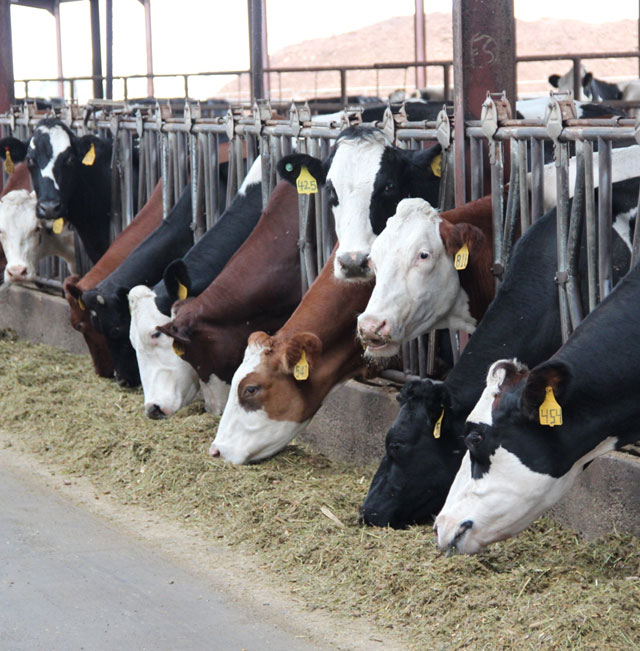Research in the Journal of Dairy Science® examines generational effects of crossbreeding
Philadelphia, August 24, 2020 – Since 1960, Holstein dairy cows have exhibited a substantial decline in fertility, with serious economic consequences for farmers. Genetic selection programs in the United States and elsewhere have emphasized milk production at the expense of other traits. Attention has turned to improving these neglected traits for better overall well-being of cows and to ameliorate dairy producers’ profitability. In a recent article appearing in the Journal of Dairy Science, scientists from the University of Minnesota examined the effects of crossbreeding on fertility and milk production across three generations in a large sample of Holstein and crossbred cows.
Although in recent years Holstein breeding programs have made strides toward remedying the problem of diminished fertility, crossbreeding is often seen as a possible means to achieve greater and more rapid gains, while eliminating concerns about inbreeding.
“A larger response in phenotypic fertility will be experienced over a shorter period of time from crossbreeding than from selection within a pure Holstein population,” explained lead author Amy Hazel, PhD, University of Minnesota, St. Paul, MN, USA. Whether this is true, and whether crossbred cows can compete with Holsteins in a high-producing commercial dairy setting, were questions that the team investigated.
Purebred Holsteins were compared with cows from a three-breed rotation of Holstein with Viking Red and Montbéliarde in this 10-year study with initial enrollment of 3,550 Holstein cows from Minnesota commercial dairies. The team found that each combination of two- and three-breed crossbred cows demonstrated significant advantages over pure Holsteins for all fertility traits at each studied lactation. This confirmed expectations, but what about the possibility that milk production might be negatively affected by crossbreeding? “Because of the global predominance of high-producing Holsteins, some dairy producers have been concerned that crossbred cows will have poorer milk production traits,” observed Prof. Hazel. “But our study found little, if any, loss of fat and protein production for crossbred cows compared with their Holstein herdmates.”

Caption: this study establishes the Viking Red and Montbéliarde breeds as highly complementary for crossbreeding with Holsteins and well suited for milk production in high-performance dairy herds. Credit: A.R. Hazel, B.J. Heins, and L.B. Hansen.
As dairy producers place increased emphasis on minimizing the major expenses for cows—including feed intake, repeated inseminations, health treatments, and premature replacement—this large and carefully designed study confirms that strategic crossbreeding can improve fertility of dairy herds, reduce costs of insemination, and result in more efficient milk production, without significant losses in milk composition. Additionally, a larger effect should be the longer herd life of crossbred cows compared with pure Holsteins. Although further research remains to be performed, this study establishes the Viking Red and Montbéliarde breeds as highly complementary for crossbreeding with Holsteins and well suited for milk production in high-performance dairy herds.
Notes for editors
The article is “Fertility and 305-day production of Viking Red-, Montbéliarde-, and Holstein-sired crossbred cows compared with Holstein cows during their first 3 lactations in Minnesota dairy herds,” by A.R. Hazel, B.J. Heins, and L.B. Hansen (https://doi.org/10.3168/jds.2020-18196). It appears in the Journal of Dairy Science, volume 103, issue 9 (September 2020), published by FASS Inc. and Elsevier. It is available at https://www.journalofdairyscience.org/article/S0022-0302(20)30505-1/fulltext.
Full text of the article is available to credentialed journalists upon request. Contact Eileen Leahy at +1 732 238 3628 or jdsmedia@elsevier.com to obtain copies. Journalists wishing to interview the authors should contact the corresponding author, Amy R. Hazel, University of Minnesota, at haze0025@umn.edu.
About the Journal of Dairy Science
The Journal of Dairy Science® (JDS), an official journal of the American Dairy Science Association®, is co-published by Elsevier and FASS Inc. for the American Dairy Science Association. It is the leading general dairy research journal in the world. JDS readers represent education, industry, and government agencies in more than 70 countries, with interests in biochemistry, breeding, economics, engineering, environment, food science, genetics, microbiology, nutrition, pathology, physiology, processing, public health, quality assurance, and sanitation. JDS has a 2019 Journal Impact Factor of 3.333 and 5-year Journal Impact Factor of 3.432 according to Journal Citation Reports (Source: Clarivate 2020). www.journalofdairyscience.org
About the American Dairy Science Association (ADSA)
The American Dairy Science Association (ADSA) is an international organization of educators, scientists, and industry representatives who are committed to advancing the dairy industry and keenly aware of the vital role the dairy sciences play in fulfilling the economic, nutritive, and health requirements of the world's population. It provides leadership in scientific and technical support to sustain and grow the global dairy industry through generation, dissemination, and exchange of information and services. Together, ADSA members have discovered new methods and technologies that have revolutionized the dairy industry. www.adsa.org
About Elsevier
Elsevier is a global information analytics business that helps scientists and clinicians to find new answers, reshape human knowledge, and tackle the most urgent human crises. For 140 years, we have partnered with the research world to curate and verify scientific knowledge. Today, we’re committed to bringing that rigor to a new generation of platforms. Elsevier provides digital solutions and tools in the areas of strategic research management, R&D performance, clinical decision support, and professional education; including ScienceDirect, Scopus, SciVal, ClinicalKey, and Sherpath. Elsevier publishes over 2,500 digitized journals, including The Lancet and Cell, 39,000 e-book titles and many iconic reference works, including Gray’s Anatomy. Elsevier is part of RELX, a global provider of information-based analytics and decision tools for professional and business customers. www.elsevier.com
Media contacts:
Eileen Leahy
Elsevier
+1 732 238 3628
jdsmedia@elsevier.com
Ken Olson, PhD, PAS
American Dairy Science Association®
+1 630 237 4961
keolson@prodigy.net